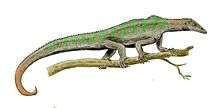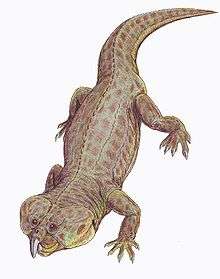Halazhaisuchus
| Halazhaisuchus Temporal range: Early Triassic | |
|---|---|
 | |
| Halazhaisuchus qiaoensis and Turfanosuchus shageduensis vertebrae | |
| Scientific classification | |
| Kingdom: | Animalia |
| Phylum: | Chordata |
| Class: | Reptilia |
| Family: | †Euparkeriidae (?) |
| Genus: | †Halazhaisuchus Wu, 1982 |
| Type species | |
| †Halazhaisuchus qiaoensis Wu, 1982 | |
Halazhaisuchus is an extinct genus of archosauriform from the Early Triassic of China. It is known from a single species, Halazhaisuchus qiaoensis, which was named in 1982 from the lower Ermaying Formation in Shaanxi. It was assigned to the family Euparkeriidae as a close relative of the genus Euparkeria from South Africa. Halazhaisuchus is known from a single holotype specimen called V6027, which was discovered in 1977 and includes a portion of the vertebral column, some ribs, two scapulae and two humeri, the right radius and ulna, and a left coracoid. Two rows of plate-like bones called osteoderms run along the length of the vertebrae. When it was first described in 1982, Halazhaisuchus was considered a close relative of Euparkeria because it has primitive features like small intercentra bones between the vertebrae and a large coracoid, not seen in later archosaurs.[1] However, these features are common to many early archosauriforms and are not unique to Euparkeriidae.[2]
The fauna of the lower Ermaying Formation closely resemble those of the Cynognathus Assemblage Zone in South Africa. Halazhaisuchus is similar to Euparkeria, while the Chinese Parakannemeyeria and Guchengosuchus resemble the South African Kannemeyeria and Erythrosuchus, respectively.[3]
References
- ↑ Wu, X. (1982). "Two pseudosuchian reptiles from Shan-Gan-Ning Basin" (PDF). Vertebrata PalAsiatica. 20: 289–301.
- ↑ Borsuk−Białynicka, M.; Evans, S.E. (2009). "Cranial and mandibular osteology of the Early Triassic archosauriform Osmolskina czatkowicensis from Poland" (PDF). Palaeontologica Polonica. 65: 235–281.
- ↑ Sues, H.-D.; Fraser, N.C. (2010). "Early and early Middle Triassic in Laurasia". Triassic Life on Land: The Great Transition. New York: Columbia University Press. ISBN 0-231-13522-X. ISBN 9780231135221.


